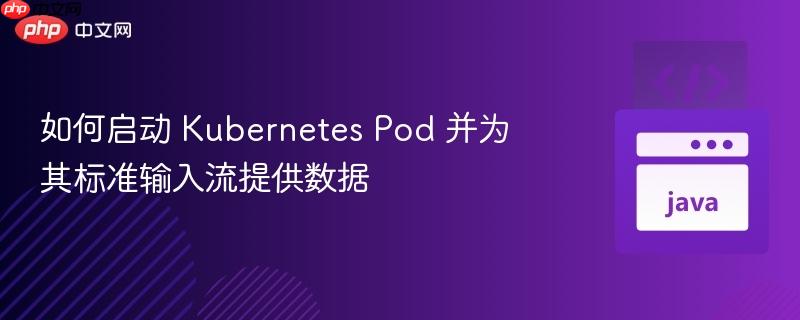
本文详细介绍了如何在 Kubernetes 中启动一个 Pod 并为其标准输入流(stdin)提供数据,特别适用于需要将二进制数据(如 `tar.gz` 文件)直接传输到容器内部进行处理的场景。我们将通过 `kubectl run -i` 命令结合管道操作,实现将本地数据流式传输至新创建的 Pod,并探讨其在 Kaniko 等特定工具链中的应用,同时提供编程实现思路和注意事项。
1. 理解 Kubernetes Pod 的标准输入流
在 Kubernetes 中,每个 Pod 内部运行的容器都拥有其自己的标准输入(stdin)、标准输出(stdout)和标准错误(stderr)流。通常情况下,我们主要关注 stdout 和 stderr 来获取容器的日志输出。然而,在某些特定场景下,我们需要像对待本地进程一样,将数据通过 stdin 输入到容器中。例如,当容器内的应用程序设计为从 stdin 读取配置、数据或文件时,这种能力就变得至关重要。
一个典型的应用场景是利用 Kaniko 工具在 Kubernetes 集群内部构建 Docker 镜像。Kaniko 支持通过 --context tar://stdin 选项从标准输入读取一个 tar.gz 格式的构建上下文,这要求我们能够将本地生成的 tar.gz 文件直接流式传输给 Kaniko 容器。
2. 使用 kubectl run -i 启动 Pod 并连接 stdin
Kubernetes 命令行工具 kubectl 提供了一个强大的命令 run,它不仅可以创建 Pod,还能通过 -i(或 --stdin)选项将其标准输入连接到本地终端的标准输入。结合管道(|)操作符,我们可以轻松地将本地数据流式传输到新创建的 Pod 中。
2.1 核心命令结构
要实现这一目标,基本的命令结构如下:
echo "你的输入数据" | kubectl run -i--image= --restart=Never
让我们分解这个命令的关键部分:
- echo "你的输入数据": 这代表了你希望传输到 Pod 的本地数据流。在实际应用中,它可以是任何生成数据的命令,例如 cat your_file.tar.gz、gzip -c file | tar -c 等。
- |: 管道操作符,将左侧命令的 stdout 作为右侧命令的 stdin。
-
kubectl run -i
--image= :- kubectl run: 用于创建并运行一个 Pod。
- -i (或 --stdin): 至关重要,它告诉 kubectl 将本地的标准输入连接到新创建的 Pod 的标准输入。
: 你为 Pod 指定的名称。 - --image=
: 指定容器要使用的 Docker 镜像。
- --restart=Never: 这个选项对于一次性任务(如 Kaniko 构建)非常重要。它指示 Kubernetes 在容器完成其工作并退出后,不要尝试重新启动它。这使得 Pod 的行为更像一个 Kubernetes Job,在任务完成后自动终止。
2.2 示例:向 BusyBox Pod 传递命令
考虑一个简单的例子,我们想启动一个 busybox 容器,并让它执行一个从 stdin 接收到的 echo foo 命令:
echo "echo foo" | kubectl run -i busybox-test --image=busybox --restart=Never
执行流程解释:
- echo "echo foo" 命令将字符串 "echo foo" 输出到标准输出。
- 管道 | 将这个字符串作为 kubectl run 命令的标准输入。
- kubectl run -i busybox-test --image=busybox --restart=Never 命令创建了一个名为 busybox-test 的 Pod,使用 busybox 镜像,并将其标准输入连接到 kubectl 进程的 stdin(即来自 echo 命令的 "echo foo")。
- busybox 容器启动后,如果其入口点(ENTRYPOINT)或命令(CMD)被配置为从 stdin 读取输入(例如,直接执行 sh 或其他解释器),它将接收并执行 "echo foo" 这个命令。
- 容器执行完毕后,由于 --restart=Never 选项,Pod 将进入 Completed 状态并最终被回收。
3. 应用于 Kaniko 构建上下文传输
回到 Kaniko 的具体场景,如果你的本地有一个动态生成的 .tar.gz 文件(例如,通过 tar -czf - . 命令生成),你可以这样将其传输给 Kaniko 容器:
tar -czf - . | kubectl run -i kaniko-builder --image=gcr.io/kaniko-project/executor:latest --restart=Never --command -- /kaniko/executor --context tar://stdin --destination your-registry/your-image:tag
命令详解:
- tar -czf - .: 这个命令会在当前目录(.)下创建并压缩一个 tar.gz 归档,并通过 -f - 选项将其直接输出到标准输出。这是 Kaniko 所期望的构建上下文格式。
- |: 将 tar 命令的输出作为 kubectl run 的输入。
- kubectl run -i kaniko-builder --image=gcr.io/kaniko-project/executor:latest --restart=Never: 启动 Kaniko 容器,并连接其 stdin。
-
--command -- /kaniko/executor --context tar://stdin --destination your-registry/your-image:tag:
- --command: 覆盖容器的默认入口点(ENTRYPOINT),因为 kubectl run 默认会尝试将参数作为 CMD 传递。这里我们明确指定要执行的命令是 /kaniko/executor。
- --: 这是一个惯例,用于将后续的参数视为命令的参数,而不是 kubectl run 自身的参数。
- /kaniko/executor: Kaniko 执行器在容器内的路径。
- --context tar://stdin: 告诉 Kaniko 从标准输入读取 tar.gz 格式的构建上下文。
- --destination your-registry/your-image:tag: 指定构建完成后镜像推送的目标地址。
4. 编程实现思路(Java/Scala)
虽然上述示例使用了 kubectl 命令行工具,但在 Java 或 Scala 等编程语言中,你同样可以通过执行外部进程的方式来实现。
- 构建 kubectl 命令: 构造一个字符串数组,包含完整的 kubectl run -i ... 命令及其所有参数。
- 创建 ProcessBuilder: 使用 java.lang.ProcessBuilder 类来创建并启动一个新进程。
- 获取进程的输出流: 通过 Process.getOutputStream() 获取到新进程的标准输入流(对于 kubectl 进程来说,这是它的 stdin,而 kubectl 会将其转发给 Pod 的 stdin)。
- 写入数据: 将你的二进制数据(例如 tar.gz 文件内容)写入到这个 OutputStream 中。
- 等待进程完成: 调用 Process.waitFor() 等待 kubectl 命令执行完毕。
Java 示例片段 (概念性):
import java.io.*;
import java.util.Arrays;
public class KubernetesStdinFeeder {
public static void main(String[] args) {
String podName = "my-kaniko-pod";
String image = "gcr.io/kaniko-project/executor:latest";
String destination = "your-registry/your-image:tag";
String kanikoCommand = "/kaniko/executor";
String kanikoContext = "--context";
String kanikoContextValue = "tar://stdin";
String kanikoDestination = "--destination";
// 构建 kubectl 命令
String[] kubectlCommand = {
"kubectl", "run", "-i", podName,
"--image=" + image,
"--restart=Never",
"--command", "--",
kanikoCommand,
kanikoContext, kanikoContextValue,
kanikoDestination, destination
};
ProcessBuilder processBuilder = new ProcessBuilder(kubectlCommand);
processBuilder.redirectErrorStream(true); // 将错误流重定向到标准输出,方便调试
try {
Process process = processBuilder.start();
// 获取 kubectl 进程的输出流,我们将数据写入到这里,kubectl 会将其转发给 Pod
try (OutputStream stdinToKubectl = process.getOutputStream();
FileInputStream tarFileInputStream = new FileInputStream("path/to/your/local.tar.gz")) {
byte[] buffer = new byte[4096];
int bytesRead;
while ((bytesRead = tarFileInputStream.read(buffer)) != -1) {
stdinToKubectl.write(buffer, 0, bytesRead);
}
stdinToKubectl.flush();
// 确保流关闭,表示数据传输完毕
}
// 读取 kubectl 命令的输出
try (BufferedReader reader = new BufferedReader(new InputStreamReader(process.getInputStream()))) {
String line;
while ((line = reader.readLine()) != null) {
System.out.println("Kubectl Output: " + line);
}
}
int exitCode = process.waitFor();
System.out.println("Kubectl process exited with code: " + exitCode);
if (exitCode != 0) {
System.err.println("Error running kubectl command.");
}
} catch (IOException | InterruptedException e) {
e.printStackTrace();
}
}
}注意事项:
- 上述 Java 示例是概念性的,需要根据实际情况调整 path/to/your/local.tar.gz。
- 确保执行 Java 程序的机器上安装了 kubectl 并且配置了正确的 Kubernetes 集群访问权限。
- 更健壮的生产级解决方案可能会考虑使用 Kubernetes 客户端库(如 Fabric8 Kubernetes Client 或官方 Java 客户端)来直接创建 Pod 并通过其 API 进行 attach/exec 操作以流式传输数据,但这通常比直接调用 kubectl run -i 更复杂,特别是对于首次创建 Pod 并立即注入 stdin 的场景。
5. 注意事项与最佳实践
- 容器设计: 确保你的容器应用程序被设计为能够从 stdin 读取数据。这意味着容器的 ENTRYPOINT 或 CMD 应该能够处理 stdin 输入。例如,直接执行一个 shell(如 /bin/sh)或一个专门处理 stdin 的程序。
- Pod 生命周期: 使用 --restart=Never 对于一次性任务至关重要,它能确保 Pod 在任务完成后自动终止,避免资源浪费。
- 错误处理: 在编程实现中,务必捕获 IOException 和 InterruptedException,并检查 kubectl 进程的退出码,以确保命令成功执行。
- 数据量: 对于非常大的数据量,考虑网络带宽和 Kubernetes API 服务器的负载能力。虽然 stdin 流式传输通常效率很高,但极端情况下可能需要优化数据生成或传输策略。
- 安全性: 确保你传输的数据是安全的,并且只有授权的用户或服务能够执行此类操作。
-
替代方案:
- ConfigMap/Secret: 对于少量、静态的数据,可以考虑将其存储在 ConfigMap 或 Secret 中,然后挂载到 Pod 内。但这不适用于动态生成的大型二进制文件。
- PersistentVolume: 对于需要持久化存储的数据,可以挂载 PersistentVolume,但这也增加了复杂性,且不适合直接的 stdin 流传输场景。
- Sidecar 容器: 可以在主容器旁边运行一个 Sidecar 容器,负责将数据下载或生成到共享卷,然后主容器从该卷读取。
总结
通过 kubectl run -i 命令,我们可以有效地在 Kubernetes 中启动一个新 Pod 并为其标准输入流提供数据,这为处理需要动态输入数据的容器化应用(如 Kaniko 构建)提供了一个直接且强大的解决方案。无论是通过命令行手动操作,还是通过编程语言自动化实现,理解并正确运用 kubectl run -i 都是管理 Kubernetes 工作负载的重要技能。






























